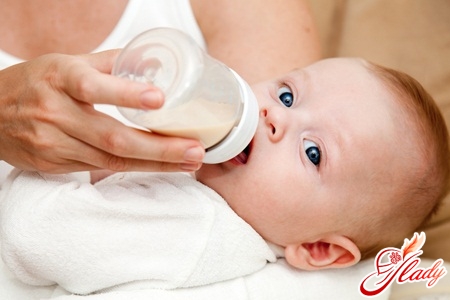 All young parents are extremely interested inabsolutely everything related to children. Including the features of the digestive organs in children. There is no doubt that the digestive system of babies differs from that of adults. But what exactly are these differences? This is exactly what we will try to find out today in this article.
All young parents are extremely interested inabsolutely everything related to children. Including the features of the digestive organs in children. There is no doubt that the digestive system of babies differs from that of adults. But what exactly are these differences? This is exactly what we will try to find out today in this article.
And how did it all start?
And let's start talking about the featuresdigestive system in children from the very beginning, namely, from the moment of implantation of the egg into the mucous membrane of the uterus. After all, at this stage of development, nutrition is simply vital for the fetus. As soon as the embryo is implanted in the uterus, it begins to feed on the secretion produced by the mucous membrane of the uterus. After about a week, the embryo begins to feed on the contents of the yolk sac. And already from about the middle of the second month of pregnancy, the baby's nutrition becomes hemotrophic - that is, the fetus receives nutrients from the mother's body, with the help of the placenta. However, the fetus's own digestive system does not remain on the sidelines - it takes direct part in the processing of such nutrients as protein, water, glucose and others, received by it from the mother's body. Despite the fact that the maturation of the digestive system in the fetus occurs extremely quickly, the child is born with a very significant physiological immaturity of the salivary glands, pancreas, liver and other organs responsible for proper digestion. Fortunately, nature is extremely wise. She also foresaw this - the first few months after the baby is born, the only food product for him is mother's milk. Mother's milk is not only easily absorbed by the baby's still immature digestive system, but also fully satisfies all his physiological needs. By the way, all this is also true for artificial milk formulas. Although, of course, if it is possible to breastfeed the baby, it is better to give preference to mother's milk.
Salivary glands
Anatomical formation of the baby's salivary glandsends by the time of birth. But the secretory function of the salivary glands is still far from ideal. And they will begin to function fully only at 4 - 5 months. By the way, the active production of saliva that occurs in a child at this age is very often taken by parents as a signal that the baby is starting to cut teeth. In fact, strong salivation in a baby is due to the pronounced immaturity of the mechanisms regulating salivation and swallowing. Saliva plays a very important role in the digestion of the baby - in the first few months of life it is necessary for the correct sealing of the mouth during sucking. In addition, it is with the help of saliva that small clots of casein are formed - a substance contained in mother's milk. And at the time when the first complementary foods are introduced into the child's diet, the role of saliva simply cannot be overestimated. It is simply necessary for the correct food lump to form. If this does not happen, then there is a very high probability that the baby will develop a variety of digestive problems.
Pancreas and liver
By the time the baby is born,the pancreas is still relatively immature. Although it copes very easily with the breakdown of those easily digestible nutrients that are in mother's milk or artificial milk mixtures. By the way, if the child is on artificial feeding, the maturation of the pancreas occurs much faster. In all other babies who eat mother's milk, the final maturation of the pancreas occurs at the time when complementary foods are introduced into their diet. It is the pancreas that supplies the duodenum with juice containing such enzymes as lipase, which breaks down fats, and trypsin, which breaks down carbohydrates. And, of course, it is the pancreas that produces the hormone insulin, which plays a huge role in the regulation of carbohydrate metabolism. If insulin is produced in insufficient quantities, there is a very high probability of developing such an unpleasant disease as diabetes. The pancreas secretes pancreatic juice into the duodenum, which contains enzymes: trypsin, which digests proteins, lipase, which breaks down fats, and amylase, which breaks down carbohydrates. In addition, the pancreas produces the hormone insulin, which is the main regulator of carbohydrate metabolism. Insufficient insulin production leads to a serious disease called diabetes. Liver. Despite the fact that the size of the liver of a newborn baby is quite large, it is still far from functional maturity. The secretion of those bile acids that are necessary for digesting solid food is still too small. It begins at about the same time when additional complementary foods are introduced into the baby's diet. At the time of birth, the baby's liver is approximately twice as large as that of an adult. Of course, in percentage terms relative to body size. But, as mentioned above, the baby's liver is still very, very immature. Although, despite this, the liver successfully copes with many of the functions assigned to it. The liver is a real storehouse of many nutrients, such as fats, glycogen, proteins. And another extremely important function of the liver is antitoxic. It is the liver that is one of the main "filters" that remove all toxic substances from the human body.
Stomach
Despite the fact that the volume of the stomachof a newborn baby is rapidly increasing, its secretory function is extremely weak. Its full functioning begins at about the 9th - 10th month of the baby's life. And the anatomical and physiological features of the baby's stomach are very peculiar. The bottom of the stomach is extremely poorly developed, as is the entire muscle layer. But the entrance to the stomach of a small child is still quite wide. It is the combination of all these three factors that leads to the fact that small children regurgitate very often. And vomiting is also a fairly common phenomenon. Although, of course, the baby swallowing air while sucking also makes its contribution. The mucous membrane of the child's stomach is extremely delicate, abounding in blood vessels. The child's stomach has all the same glands that adults have. And that is why the child's gastric juice contains almost all the "adult" components, such as rennet, pepsin, hydrochloric acid, lipase and many, many others. However, of course, in a completely different percentage ratio than in adults. For example, rennet is extremely important for a child's digestion - it is what causes milk to curdle. By the way, human milk curdles more slowly than cow's milk, which is used to make most formulas. After milk curdles, pepsin comes into play, which is designed to break down milk proteins. And fats are broken down by lipase.
Oral cavity
The child's oral cavity also has its ownFeatures that are somehow related to sucking milk. The baby's oral cavity itself is still very small - due to the low palate, which does not yet have a vault. The tongue of a small child is wide and short, with clearly defined papillae. In addition, the child has extremely well-developed chewing muscles. It is thanks to this entire complex that the baby manages to grasp the nipple of the mother's breast very tightly. Negative pressure is created in his mouth, due to which milk enters the baby's oral cavity. If the baby was born full-term, all sucking and swallowing reflexes are very well developed. The mucous membrane of the oral cavity of a child is extremely rich in blood vessels, but very dry. Remember, we talked about the fact that saliva in babies in the first months of life is not yet produced in full. All the food consumed by the child is liquid, so no problems arise. But here it is worth reminding parents that due to the increased dryness of the oral cavity, the mucous membrane is especially sensitive. Therefore, it is necessary to treat it with increased attention and caution. Make sure that the child does not put rough diapers or toys into his mouth. Otherwise, abrasions and wounds may appear on the surface of the child's mucous membrane. These injuries are extremely painful and can lead to the child not being able to suck out the amount of milk he needs. The saliva of a child, as well as that of any other person, contains various enzymes that begin to break down food in the oral cavity. Of course, we are now talking about complementary feeding, not about milk.
Intestines
The intestines also play an equally important role in digestion.In babies, the intestines compensate for the immaturity of all other organs of the digestive system. After all, it is the child's intestines that are responsible for membrane digestion, which is so important for a baby who eats mother's milk or formula. It is in the intestines that the instant breakdown of nutrients into components occurs. And from the intestines, these same nutrients are absorbed into the blood. As the food that has entered the stomach is digested, under the influence of intestinal peristalsis, it moves into the intestines. Its first stage is the duodenum, where further digestion occurs under the influence of enzymes produced by the pancreas and liver. Leaving the duodenum, food enters other parts of the small intestine, where it continues to be digested under the influence of intestinal juices. This is where the process of digestion of food is completed. By the way, the length of the intestines in a child is twice as long as that of an adult - it is six times longer than the height of the baby. The child's intestines have very active peristalsis - they perform two types of movements:
- Wormlike movements
With the help of this type of movement, food moves through the various sections of the intestine. Without these movements, the normal digestion process is simply impossible.
- Pendulum movements
With the help of pendulum-like movements it happensthe process of digesting food itself, as well as its subsequent absorption into the blood of a person - in this case, a child. Normally, intestinal peristalsis in an adult occurs under the influence of food that has entered it. However, in babies, peristalsis can occur and intensify not only due to the mechanical action of food, but also under the influence of some other factors: prolonged crying of the child, overheating, excessive physical activity. The mucous membrane of the child's intestines is extremely delicate and sensitive, and its walls have an exceptionally high permeability. This is why intestinal infections and toxins are especially dangerous for a small child. They very quickly penetrate the intestinal wall into the circulatory system, thereby provoking the development of intoxication, sometimes very strong. In small children, the most common food poisoning can result in such serious consequences as heart failure, meningitis, etc.
Germs of the gastrointestinal tract
During intrauterine development, the intestinesthe baby is absolutely sterile. However, just a few hours after birth, the baby's intestines are populated by a huge number of various bacteria. They enter the baby's body through the nose, mouth, and anus. Around the second day after birth, a huge number of various bacteria can be found in the baby's feces. Moreover, there are practically no bacteria in either the stomach or the upper intestines. They are mainly localized in the large intestine and the lower part of the small intestine. What microbes predominate in the baby's intestines depends solely on the nature of the baby's feeding. If the baby is fed breast milk, which is extremely rich in carbohydrates, the baby's intestines will be dominated mainly by those bacteria that are necessary for the fermentation of carbohydrates. This is the microflora that is physiological for a breastfed baby. In the same case, if the baby receives artificial milk formulas made from cow's milk, E. coli predominates in his intestines. Unfortunately, this intestinal microflora is no longer physiological for the baby. And therefore, under the influence of unfavorable factors, they can provoke the development of various intestinal diseases. That is why most often intestinal disorders affect those children who are bottle-fed.
Children's chair
The issue of the child's stool cannot be ignored.After all, in infancy, the baby's feces can tell a lot about his health. Within the physiological norm, in the first day or two after birth, the child should pass original feces - meconium. Meconium has a viscous oily consistency and a dark green color. Meconium has no odor and is sterile. It is formed in the baby's intestines during intrauterine development - from digestive juices, swallowed amniotic fluid and intestinal epithelium. Normal feces appear around the third day. They consist mainly of the remains of undigested milk, digestive juices, salts and bacteria. In children of the first months of life, stool is, as a rule, two or three times a day. However, very often stool in the first four to five weeks of life is much more frequent - 8 - 9 times a day, sometimes even has a liquid consistency. Of course, almost all mothers are very scared, believing that the baby is very sick. However, if the child's general health does not suffer in any way, the baby eats well and gains weight within the normal range, such frequent stools should not be treated with increased anxiety. Of course, it is still necessary to tell the doctor - pediatrician about this. However, in most cases, doctors associate such a phenomenon with the insufficiently rapid adaptation of the baby to the still new conditions of life outside the mother's body. This happens especially often in children who were born in a hurry, or were born weak and with low body weight. However, there is also the opposite situation, in which children who are fed with the same mother's milk have a stool only once every two or three days. And this is explained very simply - mother's milk is digested very well. And it is absorbed almost completely, which means that there is practically no waste left. By the way, babies who are fed artificial mixtures made from cow's milk have darker stools, thicker consistency and a more unpleasant smell. As the child grows, the stool becomes less and less frequent. However, of course, the digestion is still very far from complete maturity. The digestive tract fully matures only by the age of 15-16. Until then, parents will have to constantly take into account the peculiarities of digestion in children when making up their menu. We recommend reading:









